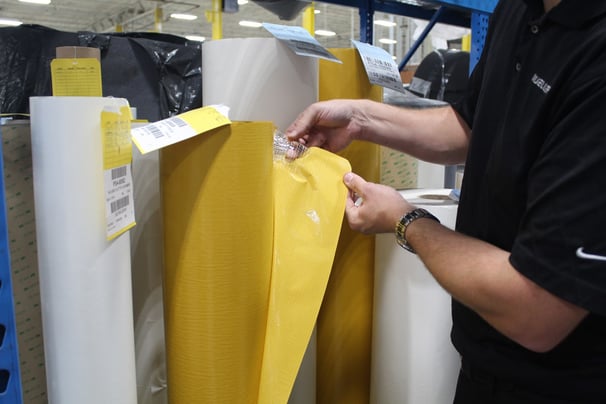 When choosing the proper adhesive for your part it is imperative to know the application. Will the part be wrapping around an object? Will the parts be laying flat? Is there an extreme bend (90°, 180°, etc.)? These are the types of questions that when answered up front can determine whether your part will perform to expectations or fail once placed on the production parts.
When choosing the proper adhesive for your part it is imperative to know the application. Will the part be wrapping around an object? Will the parts be laying flat? Is there an extreme bend (90°, 180°, etc.)? These are the types of questions that when answered up front can determine whether your part will perform to expectations or fail once placed on the production parts.
The two most prominent adhesives with electronic applications are rubber-based and acrylic-based, each bring their own pros and cons and occupy their own spaces in the market.
There is plenty to consider when choosing the correct adhesive for any given job. At Mueller, we are dedicated to providing our customers with all of the information needed to make the proper decision for whatever the application might be. 
What is a Rubber-Based Adhesive?
Rubber-based adhesives are among the most highly used in the electronics manufacturing industry, and for a good reason. These adhesives have high initial tack, meaning they adhere to most surfaces quickly. Rubber-based adhesives are also very soft and adaptable, making them useful for applying in many different situations. This type of adhesive also wets out faster than most, meaning it can spread and fill irregular surfaces and areas with ease.
According to Mueller expert Mike Bryant, rubber-based adhesives are best suited for situations where its high tack can be properly utilized. “If you have a situation where you want to bond to a foam or rubber and immediately be able to apply it to something, the rubber is going to work fast.”
This type of adhesive is very adaptable, sticking to most surfaces and materials, as well as being very cost-effective.
What is an Acrylic-Based Adhesive?
Acrylic-based adhesives remain a staple in the industry due to their wide range of uses, as well as their long-lasting nature. This adhesive may take longer to adhere to materials, but it makes up for it by lasting years without drying out or delaminating. In addition, acrylic-based adhesives have higher heat resistance and are also resistant to plasticizer migration, which can negatively affect other types of adhesive.
When asked about the best uses for acrylic-based adhesives, Bryant said the following, “They are often used more like a permanent bond versus a temporary placement adhesive. They’re going to last much longer.”
Essentially, this adaptable adhesive type makes up for its slow adhesion time with a long lifespan and a high resistance to environmental complications.
.jpg)
Pros and Cons: Comparing Rubber-Based and Acrylic-Based Adhesives
Now that you’re familiar with both types of adhesives, it’s time to look at what sets them apart. Both are very useful in many situations, but that doesn’t make them interchangeable.
While rubber-based adhesives do have a high tack rate, they do not maintain their adhesion for nearly as long as acrylic-based adhesives do. This means that over time, rubber-based adhesives can dry out and lose their adhesion. Meanwhile, acrylic-based adhesives maintain their adhesion for years, making them the ideal choice for electronic products that are mainly held together by adhesives.
Likewise, acrylic-based adhesives are better suited for outdoor appliance use, or for any products that might be exposed to the elements, as they have a higher heat and UV ray resistance than rubber-based adhesives. Acrylic-based can withstand heat into the mid-200 degrees Fahrenheit, while rubber-based adhesives have a lower heat resistance.
Rubber-based adhesives excel in the short term; if used as an application agent or as a temporary placement adhesive to aid in the setup of a product, this high tack and fast-acting adhesive is perfect. Acrylic-based adhesives take time to setup and adhere, which is often inconvenient during the assembly process.
It is also important to consider the cost-effectiveness of both adhesives. Rubber-based adhesives are about 25-30% cheaper than acrylic-based ones. This cost difference is a result of the manufacturing process cost for both types of adhesive.
Rubber-based adhesives are created as a hotmelt adhesive before being heated, softened, rolled, and then applied, and there are no extra steps required. For acrylic-based adhesives, the glue itself is mixed with solvents, which then have to be flashed off before use. The result is a process that takes longer and costs more to do than the rubber-based creation.
Which Adhesive Should I Use?
With all this information in mind, now it is time to decide which adhesive is right for you.
In all honesty, there is no definite answer to which adhesive is better or more useful. Both rubber-based and acrylic-based adhesives serve their own purposes during the manufacturing process.
However, if you are creating a piece of electronic equipment that is entirely reliant on adhesives to hold it together, then an acrylic-based adhesive is the clear answer. On the other hand, if you need parts or components held together temporarily before they are fastened together by another method, then rubber-based adhesives are right for you.
Bryant, said it best when he said, “It is more about the application than the material,” which means that you can use whichever adhesive you feel best suits your needs.
No matter which adhesive you choose, we hope that this guide gives you a clear sense of which applications are best suited to each adhesive, so you can make the most informed decision possible.





